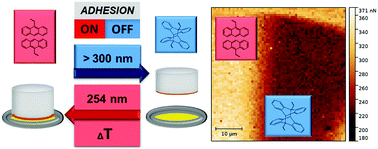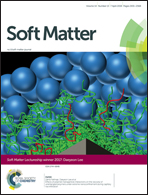Switching “on” and “off” the adhesion in stimuli-responsive elastomers†
Abstract
The present work aims at the preparation of dry adhesives with switchable bonding properties by using the reversible nature of the [4πs+4πs] cycloaddition of anthracenes. Photo-responsive hydrogenated carboxylated nitrile butadiene rubber with photo-responsive pendant anthracene groups is prepared by one-pot synthesis. The formation of 3D networks relies on the photodimerization of the anthracene moieties upon UV exposure (λ > 300 nm). Controlled cleavage of the crosslink sites is achieved by either deep UV exposure (λ = 254 nm) or thermal dissociation at 70 °C. The kinetics of the optical and thermal cleavage routes are compared in thin films using UV-vis spectroscopy and their influence on the reversibility of the network is detailed. Going from thin films to free standing samples the modulation of the network structure and thermo-mechanical properties over repeated crosslinking and cleavage cycles are characterized by low-field NMR spectroscopy and dynamic mechanical analysis. The applicability of the stimuli-responsive networks as adhesives with reversible bonding properties is demonstrated. The results evidence that the reversibility of the crosslinking reaction enables a controlled switching “on” and “off” of adhesion properties. The recovery of the adhesion force amounts to 75 and 80% for photo- and thermal dissociation, respectively. Spatial control of adhesion properties is evidenced by adhesion force mapping experiments of photo-patterned films.



 Please wait while we load your content...
Please wait while we load your content...